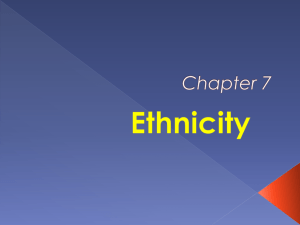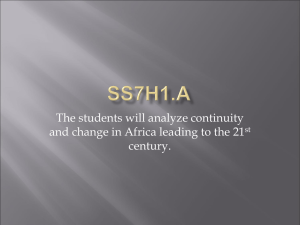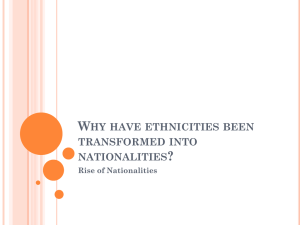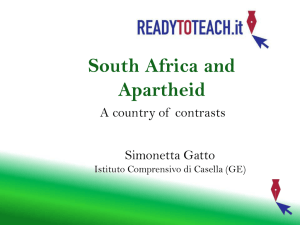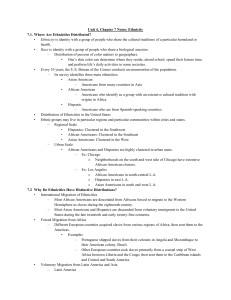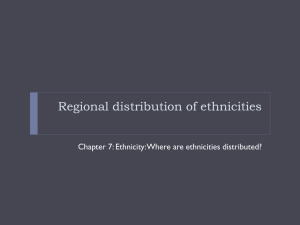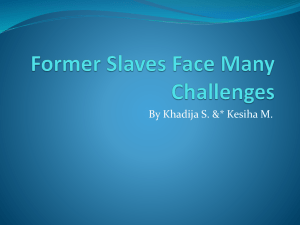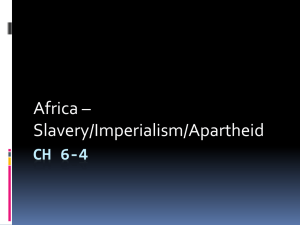Chapter 7: Ethnicity
advertisement
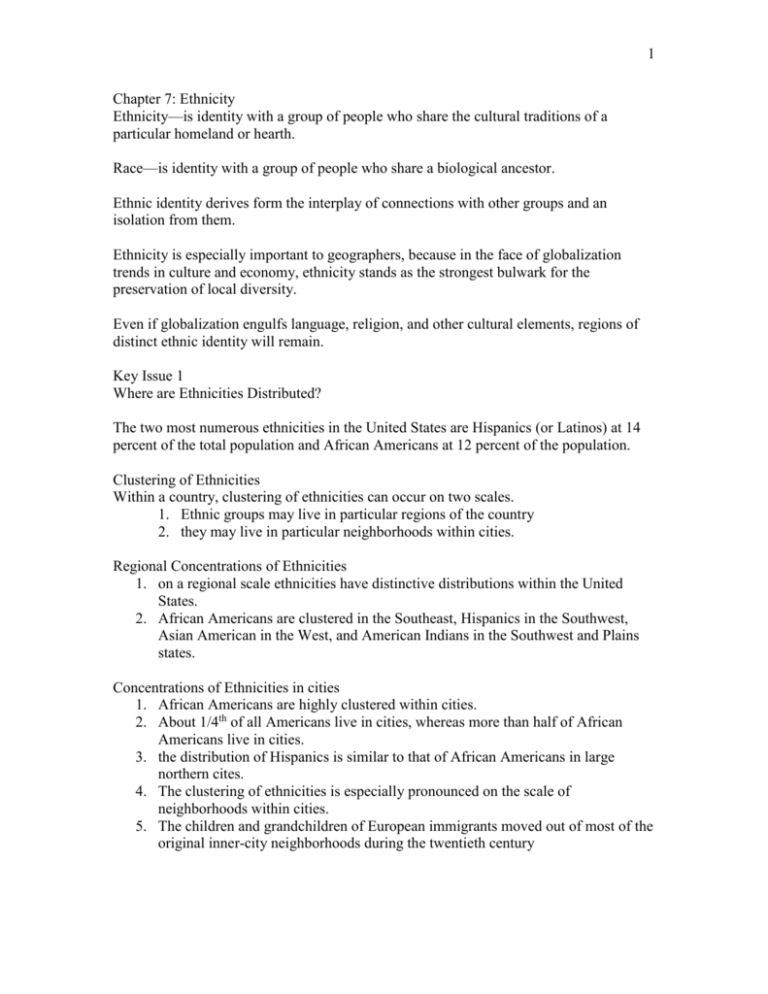
1 Chapter 7: Ethnicity Ethnicity—is identity with a group of people who share the cultural traditions of a particular homeland or hearth. Race—is identity with a group of people who share a biological ancestor. Ethnic identity derives form the interplay of connections with other groups and an isolation from them. Ethnicity is especially important to geographers, because in the face of globalization trends in culture and economy, ethnicity stands as the strongest bulwark for the preservation of local diversity. Even if globalization engulfs language, religion, and other cultural elements, regions of distinct ethnic identity will remain. Key Issue 1 Where are Ethnicities Distributed? The two most numerous ethnicities in the United States are Hispanics (or Latinos) at 14 percent of the total population and African Americans at 12 percent of the population. Clustering of Ethnicities Within a country, clustering of ethnicities can occur on two scales. 1. Ethnic groups may live in particular regions of the country 2. they may live in particular neighborhoods within cities. Regional Concentrations of Ethnicities 1. on a regional scale ethnicities have distinctive distributions within the United States. 2. African Americans are clustered in the Southeast, Hispanics in the Southwest, Asian American in the West, and American Indians in the Southwest and Plains states. Concentrations of Ethnicities in cities 1. African Americans are highly clustered within cities. 2. About 1/4th of all Americans live in cities, whereas more than half of African Americans live in cities. 3. the distribution of Hispanics is similar to that of African Americans in large northern cites. 4. The clustering of ethnicities is especially pronounced on the scale of neighborhoods within cities. 5. The children and grandchildren of European immigrants moved out of most of the original inner-city neighborhoods during the twentieth century 2 6. For the descendants of European immigrants ethnic identity is more likely to be retained through religion, food, and other cultural traditions rather than through local residence. 7. Ethnic concentrations in US cities increasingly consist of African Americans who migrate from the South, or immigrants from Latin America and Asia. African American Migration Patterns 1. The idea of migration helps to explain the clustering of ethnicities in the cities of the United States. 2. Three major migration flows have shaped the current distribution of African Americans within the United States. a. Immigration from Africa to the American colonies in the 18th C. b. Immigration from the U.S. South to northern cities during the first half of the twentieth century. c. Immigration from the inner-city ghettos to other urban neighborhoods during the second half of the twentieth and first decade of the twenty-first centuries. Forced Migration from Africa 1. Most African Americans are descended from Africans who were forced to come to the Western Hemisphere as slaves. 2. the first Africans brought to the American colonies as slaves arrived in Jamestown Virginia in 1619. 3. During the 18th C British ships brought 400,000 Africans to the 13 colonies that later formed the United States 4. 1808 US banned the import of additional slaves but an estimated 250000 were imported illegally during the next 50 years. 5. slavery was widespread during the Roman Empire 6. It was replaced by feudalism during the Middle Ages. This is the practice where serfs were tied to the land and could not leave. 7. Slavery was rare in Europe but they diffused the practice to the Western Hemisphere. 8. Slaves were used by plantation owners as a cheap and abundant source of labor. 9. The Spanish and Portuguese first participated in the slave trade in the early 16th century, and the British, Dutch, and French joined in during the next century. 10. At the height of the 18th Century slave demand a number of European countries adopted the triangular slave trade. 11. triangular slave trade—a practice, primarily during the eighteenth century, in which European ships transported slaves from Africa to Caribbean islands, molasses from the Caribbean to Europe, and trade goods from Europe to Africa. 12. The Africans were packed into ships at extremely high density, kept in chains, and provided with minimal food and sanitary conditions. Approximately 1/4th died crossing the Atlantic 13. Nearly all slaves ended up in the Southern plantations growing tobacco and cotton. 3 14. The Civil War (1861-1865) was fought to prevent 11 pro-slavery Southern states from seceding from the Union. 15. 1863 President Lincoln issued the Emancipation Proclamation freeing the slaves. 16. The 13th Amendment adopted 8 months after the South Surrendered, outlawed slavery. 17. Most freed slaves remained in the South working as sharecroppers—one who works a rented field from a landowner and pays the rent by turning over to the landowner a share of the crops. 18. The sharecroppers were kept in constant debt because they had to rent all their tools from the landowner for more shares of their crops. Immigration to the North 1. African Americans migrated north with the stimulation of factory production after World War I (1914-1918) and World War II (1939-1945). Expansion of the Ghetto 1. Differentiating Ethnicity and Race 1. Race and Ethnicity are often confused 2. In the United States, consider three prominent ethnic groups a. Asian Americans b. African Americans c. Hispanic Americans 1. Asian is recognized as a distinct race by the U.S. Bureau of the Census, so Asian as a race and Asian American as an ethnicity encompass basically the same group of people. However, the Asian American ethnicity lumps together people with ties to many countries in Asia. 2. African Americans and black are two different groups, although the 2000 census combined the two. Most black Americans are descended from African immigrants and therefore also belong to African American ethnicity. Some American blacks however, trace their cultural heritage to regions other than Africa, including Latin America, Asia, and the Pacific Islands. 3. Hispanic or Latino is not considered a race, so on the census form members of the Hispanic or Latino ethnicity select any race they wish—white, black, or other The traits that characterize race are those that can be transmitted genetically from parents to their children—ex. Lactose intolerance. At worst, biological classification by race is the basis for racism Racism—is the belief that a race is primarily determinant of human traits and capacities and that racial differences produce an inherent superiority of a particular race. A racist is a person who subscribes to the beliefs of racism 4 Ethnicity is important to geographers because it characteristics derive from the distinctive features of particular places on Earth. One feature of race that does matter to geographers is the color of skin. The distribution of persons of color matter to geographers because it is the fundamental basis by which people in many socieities sort out where they reside, attend school, recreate, and perform many activities of daily life. Race in the United States “Separate But Equal” Doctrine A distinctive feature of race relations in the United States has been the strong discouragement of spatial interaction—in the past through legal means, today through cultural preferences or discrimination. 1896 Supreme court up held the Separate but Equal doctrine which maintained separation was ok as long as the facilities were equal. The allowed for the establishment of Jim Crow laws in the South. “White Flight” 1954 Brown v. Board of Education found that having separate schools for whites and blacks was unconstitutional because no matter how equivalent the facilities, racial separation branded minority children as inferior and therefore was inherently unequal. Rather than integrate whites fled. This made possible the expansion of the black ghettos in American cities “white flight” the emigration of whites of the anticipation of blacks immigrating into the area. White flight was encouraged by unscrupulous real estate practices, especially blockbusting. Blockbusting—real estate agents convinced white homeowners living near a black area to sell their houses at low prices, preying on their fears that black families would soon into the neighborhoods and cause property values to decline. Through blockbusting, a neighborhood could change from all-white to all-black in a matter of months, and real estate agents could start the process all over again in the next white area. Division by Race in South Africa The cornerstone of the South African policy was the creation of a legal system known as apartheid 5 Apartheid—the physical separation of different races into different geographic areas. Apartheid System 1. In South Africa under the apartheid system newborn babies were classified as being one of four races—black, white, colored (mixed white and black), or Asian 2. According to recent census blacks constitute about 75 percent of South Africa’s population, whites 14 percent, colored 8 percent, and Asians 3 percent. 3. Under apartheid each of the four races had a different legal status in South Africa. 4. The apartheid laws determined where different races could live, attend school, work, shop, and own land. 5. Blacks were restricted to certain occupations and were paid far lower wages than were whites for similar work. 6. Blacks could not vote or run for political office in national elections. 7. The apartheid system was created by whites who arrived in South Africa from Holland in 1652 and settled in Cape Town in 1652 8. South Africa was cut off from most other countries in the 1970’s and 80’s because of its apartheid stance. 9. Neighboring countries supported South Africa in order to maintain the economic ties. They needed South African ports to ship their goods. 10. South Africa also played a much more important role because it provided jobs for unemployed people from much poorer neighboring countries and it supplied the more developed countries with mineral resources critical for manufacturing and chemical processes. 11. To ensure further geographic isolation of different races, the South African government designated ten so-called homelands for blacks. The white minority government expected every black to become a citizen of one of the homelands and to move there. 12. The first four home lands comprised about 9 percent of South Africa’s land area and 19 percent of its population. If the program would have been fully implemented approximately 44 percent of South Africa’s population would live on 13 percent of the land. Dismantling Apartheid 1. South Africa’s white dominated government repealed the apartheid laws in 1991, including restrictions on property ownership and classification of people at birth by race. 6 2. The African National Congress was legalized and its leader Nelson Mandela, was released from jail after more than 27 years of imprisonment 3. 1994 Mandela was elected the countries first black president. Key Issue 2: Why Have Ethnicities Been Transformed into Nationalities? Nationality—is identity with a group of people who share legal attachment and personal allegiance to a particular country. A nation or nationality is a group of people tied together to a particular place through legal status and cultural tradition. Nationality and ethnicity are similar concepts in that membership in both is defined through shared cultural values. In principle, the cultural values shared with others of the same ethnicity derive from religion, language, and material culture, whereas those shared with others of the same nationality derive from voting, obtaining a passport and performing civic duties. 1. The American nationality identifies citizens of the United States of America, including those born in the country and those who immigrated and became citizens. 2. Ethnicity identifies a group with distinct ancestry and cultural traditions, such as African Americans, Hispanic Americans, Chinese Americans, or Polish Americans 3. Race distinguishes blacks and other persons of color from whites. 4. Thus every citizen living in the United States is a member the American nationality, and every American is a member of a race, though only some Americans identify with an ethnicity. Nation-States 1. Ethnic groups have been transformed into nationalities because desire for self rule is a very important shared attitude for many of them. 2. To preserve and enhance distinctive cultural characteristics, ethnicities seek to govern themselves without interference. 3. self-determination—the concept that ethnicities have the right to govern themselves. 4. nation-state—is a state whose territory corresponds to that occupied by a particular ethnicity that has been transformed into a nationality. Yet despite continuing attempts to create nation-states, the territory of a state rarely corresponds precisely to the territory occupied by an ethnicity. Nationalism 1. a nationality, once established must hold the loyalty of its citizens to survive. 2. politicians and governments try to instill loyalty through nationalism. 7 3. nationalism—is loyalty and devotion to a nationality. It typically promotes a sense of national consciousness that exalts one nation above all others and emphasizes its culture and interests as opposed to those of other nations. 4. For many states the mass media is the most effect means of fostering nationalism. 5. Americans regard the mass media as a watchdog over government but many countries do not allow this type of freedom most own some form of mass media or its distributors. 6. States foster nationalism by promoting symbols of the nation-state, such as flags and songs. 7. Nationalism is also instilled through the creation of songs extolling the countries virtues. 8. Nationalism can have a negative impact. a. The sense of unity within a nation-state is sometimes achieved through the creation of negative images of other nation-states. 9. Nationalism is an important example of centripetal force, 10. centripetal force—is an attitude that tends to unify people and enhance support for a state 11. The word centripetal means “directed toward the center”; it is the opposite of centrifugal, which means to spread out from the center. 12. Most nation states find that the best way to achieve citizen support is to emphasize shared attitudes that unify the people. Multinational States 1. multi-ethnic state—a state that contains more than one ethnicity. 2. In some multi-ethnic states, ethnicities all contribute cultural features to the formation of a single nationality. 3. multinational states—other multi-ethnic states that contain two ethnic groups with traditions of self-determination that agree to coexist peacefully by recognizing each other as distinct nationalities. A multinational state contains two or more nationalities with traditions of self-determination. Ex. United Kingdom
